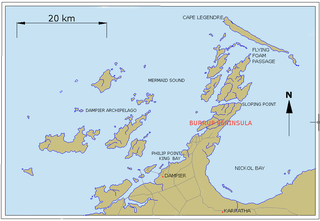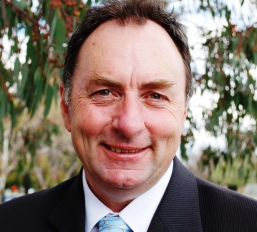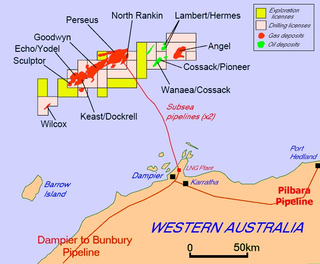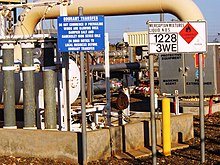
Dampier is a major industrial port in the Pilbara region in the northwest of Western Australia. It is located near the city of Karratha and Port Walcott.
Woodside Energy Group Ltd is an Australian petroleum exploration and production company. Woodside is the operator of oil and gas production in Australia and also Australia's largest independent dedicated oil and gas company. It is a public company listed on the Australian Securities Exchange and has its headquarters in Perth, Western Australia. In the 2020 Forbes Global 2000, Woodside was ranked as the 1328th-largest public company in the world.
Karratha is a city in the Pilbara region of Western Australia, adjoining the port of Dampier. It was established in 1968 to accommodate the processing and exportation workforce of the Hamersley Iron mining company and, in the 1980s, the petroleum and liquefied natural gas operations of the North West Shelf Venture. As of the 2021 census, Karratha had an urban population of 17,013. The city's name comes from the cattle station of the same name, which derives from a word in a local Aboriginal language meaning "good country" or "soft earth". The city is the seat of government of the City of Karratha, a local government area covering the surrounding region.
Alinta Limited was an Australian energy infrastructure company. It has grown from a small, Western Australia-based gas distributor and retailer to the largest energy infrastructure company in Australia. It was bought in 2007 by a consortium including Singapore Power and various parties which include the now defunct Babcock & Brown funds.
Mungarra Power Station is a power station 50 km south-east of Geraldton, Western Australia. It is natural gas powered with three gas turbines that together generate a total capacity of 112 MW of electricity.

Murujuga, formerly known as Dampier Island and today usually known as the Burrup Peninsula, is an area in the Dampier Archipelago, in the Pilbara region of Western Australia, containing the town of Dampier. The Dampier Rock Art Precinct, which covers the entire archipelago, is the subject of ongoing political debate due to historical and proposed industrial development. Over 40% of Murujuga lies within Murujuga National Park, which contains within it the world's largest collection of ancient 40,000 year old rock art (petroglyphs).

Varanus Island is the largest of the Lowendal Islands, an archipelago off the north west coast of Western Australia, near Karratha in the Pilbara region. The island is approximately 59 kilometres (37 mi) from the mainland coast. It is located at 20°39′3″S115°34′27″E.

The North West Shelf is a continental shelf region of Western Australia. It includes an extensive oil and gas region off the North West Australia coast in the Pilbara region.

Anthony David McRae is an Australian politician. He was an ALP member of the Western Australian Legislative Assembly from 2001 to 2008, representing the electorate of Riverton. McRae unexpectedly won the traditionally Liberal seat of Riverton in the 2001 Gallop-led election and held the seat at the 2005 election.

The North West Shelf Venture, situated in the north-west of Western Australia, is Australia's largest resource development project. It involves the extraction of petroleum at offshore production platforms, onshore processing and export of liquefied natural gas, and production of natural gas for industrial, commercial and domestic use within the state.
West Australian Petroleum Pty Ltd (WAPET) was a pioneer oil and gas exploration and processing company in Western Australia.

The Western Australian gas crisis was a major disruption to natural gas supply in Western Australia, caused by the rupture of a corroded pipeline and subsequent explosion at a processing plant on Varanus Island, off the state's north west coast on 3 June 2008. The plant, operated by Apache Energy, which normally supplied a third of the state's gas, was shut down for almost two months while a detailed engineering investigation and major repairs were carried out. Gas supply from the plant partially resumed in late August. By mid-October, gas production was running at two-thirds of normal capacity, with 85% of full output restored by December 2008.

The petroleum industry in Western Australia is the largest contributor to the country's petroleum exports. Western Australia's North West Shelf (NWS) is the primary location from which production originates. Oil exports are shipped from Port Hedland.
Neerabup Power Station is situated on the northern outskirts of Perth, Western Australia near the locality of Pinjar and the Pinjar Power Station. It is powered by natural gas, and has a total electrical generation capacity of 330 MW and includes a 30 km high-pressure gas linepack pipeline connected to the Dampier to Bunbury Natural Gas Pipeline.
Kwinana Cogeneration Plant was a cogeneration facility located 40 kilometres (25 mi) south of Perth, Western Australia that operated from 1994 to 2022. It provided steam and electrical power to the BP Australia Kwinana Oil Refinery and electricity to Synergy, the State owned generator/retailer.

Multinet Gas Networks (MGN) is an Australian energy company and one of three Victorian natural gas distribution networks. MGN is one of three main companies that make up Australian Gas Infrastructure Group (AGIG), the other two being Australian Gas Networks (AGN) and Dampier to Bunbury Pipeline (DBP).
The Eastern Gas Pipeline (EGP) is a 797 km (495 mi) natural gas pipeline. It is a key supply artery between the Gippsland Basin in Victoria and New South Wales, Australia. The EGP is currently operated by Jemena.
Kemerton Power Station is a power station 17 km northeast of Bunbury in Western Australia. It is located in an area known as the Kemerton Industrial Park. The location had been considered as being Kemerton, in the 1980s as a potential aluminium smelter location, but is now considered to be part of Wellesley. The consideration of the site as being appropriate as a power station site was being considered in the early 2000s.
Western Australia, like other Australian states and high-income countries, is a heavy energy user by global standards.









